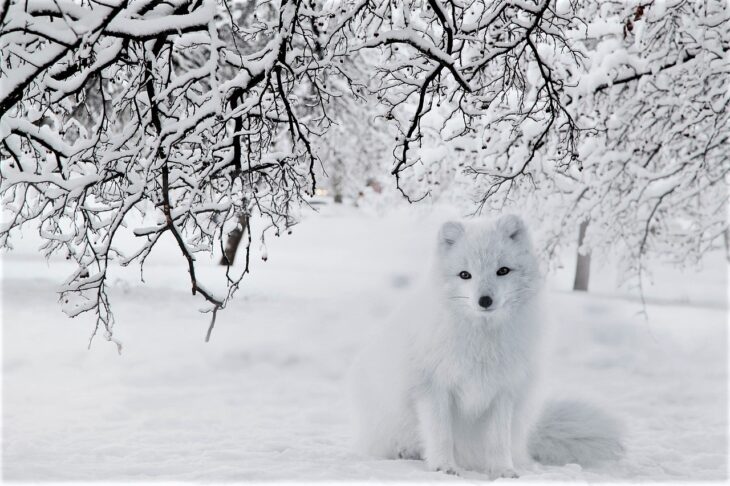Slow sleek steps,
Pounces on its paws,
Snow-clad fur,
Brushes off impatiently,
Ears perk up,
When squeals and squeaks are heard,
Steady and slowly,
Merges with the blanket beneath,
Almost at ease,
Confidently it please,
Lowers into its position,
Ready to strike,
Pounces on its paws,
Announces in its jaws,
Mouse struck beneath its claws,
Ounces in vigilant strides as it withdraws.
By Sarah Shahzad, July 2024
About Artic Hunter
The poem begins by describing the Arctic fox’s graceful and stealthy movements through the snow. The “slow sleek steps” and “pounces on its paws” emphasize its agility and precision. The “snow-clad fur” signifies its adaptation to its environment, while “brushes off impatiently” suggests the fox’s alertness and readiness to act.
The “ears perk up” at the sounds of potential prey, indicating its sharp senses. The fox’s ability to “merge with the blanket beneath” illustrates its camouflage and stealth, blending seamlessly with the snowy landscape.
In third stanza, the fox is depicted as being “almost at ease,” showing its confidence and patience as it prepares to hunt. It “lowers into its position,” readying itself for the perfect moment to pounce on its prey.
The final stanza captures the successful hunt. The fox “pounces on its paws,” and with the prey “announces in its jaws,” signifying its capture. The mouse “struck beneath its claws” represents the culmination of its stealth and precision. The fox then “ounces in vigilant strides as it withdraws,” indicating its cautious yet assured retreat with its catch.
Overall, “Arctic Hunter” paints a vivid picture of an Arctic fox’s hunting prowess, showcasing its agility, stealth, and confidence in its natural habitat.
Arctic:
The Arctic is a polar region located at the northernmost part of the Earth, characterized by extreme conditions, including low temperatures, ice-covered landscapes, and limited sunlight for much of the year. It encompasses the Arctic Ocean, adjacent seas, and parts of Canada, Greenland, Russia, the United States (Alaska), Norway, Sweden, Finland, and Iceland. Here are some key aspects of the Arctic:
Climate:
The Arctic has a polar climate with long, harsh winters and short, cool summers.
Winter temperatures can plummet to below -30°C (-22°F), while summer temperatures may rise to just above freezing.
The region experiences phenomena such as the Midnight Sun (continuous daylight during summer) and Polar Night (continuous darkness during winter).
Flora and Fauna:
Despite its harsh climate, the Arctic supports a variety of life. Vegetation primarily includes tundra species such as mosses, lichens, and small shrubs.
Wildlife includes polar bears, Arctic foxes, reindeer, seals, walruses, and various bird species. Marine life is abundant, with species like narwhals, belugas, and bowhead whales.
Human Presence:
Indigenous peoples, such as the Inuit, Sámi, and Nenets, have lived in the Arctic for thousands of years, adapting to the extreme conditions with unique cultures and lifestyles.
Modern settlements and research stations are also present, focusing on scientific study and resource extraction.
Environmental Concerns:
Climate change significantly impacts the Arctic, with rising temperatures causing ice melt, habitat loss, and shifts in wildlife populations.
Melting ice also affects global sea levels and weather patterns, making the Arctic a crucial area for climate research.
Arctic Fox:
The Arctic fox (Vulpes lag opus) is a small mammal well-adapted to the extreme conditions of the Arctic. Here are some detailed features and facts about the Arctic hunter:
Physical Adaptations:
The Arctic fox has a thick, multi-layered coat that changes color with the seasons—white in winter to blend with the snow and brown or gray in summer to match the tundra.
Its compact body, short legs, and small ears minimize heat loss.
Fur-covered feet provide insulation and traction on ice and snow.
Diet:
Arctic foxes are omnivorous and opportunistic feeders. Their diet primarily consists of small mammals like lemmings and voles, birds, eggs, insects, and carrion.
They are known to follow polar bears and scavenge leftover prey.
Behavior and Reproduction:
Arctic foxes are solitary hunters but can form pairs or small groups during the breeding season.
They build dens in the ground or snowbanks, providing shelter and a safe place to raise their young.
Females give birth to litters of up to 14 pups in spring, and both parents care for the young.
Survival Strategies:
These foxes are highly resilient, capable of enduring extreme cold and scarcity of food.
In lean times, they can reduce their metabolic rate and live off stored body fat.
They have excellent hearing, allowing them to locate prey under the snow.
Conservation Status:
While the Arctic fox is not currently endangered, certain populations face threats from climate change and competition with the red fox, which is expanding its range northward.
Conservation efforts focus on preserving their habitat and mitigating the impacts of global warming.
Understanding the Arctic and the Arctic fox highlights the remarkable adaptations of life in one of the planet’s most challenging environments and underscores the importance of conservation efforts in these fragile ecosystems.

